
 |
Home | Cho Oyu Main | Contact |
Updated: October 2011. Click on an image to see the FULL size with a caption.
The following reference information is included:
My rating scale:
 Excellent ;
Excellent ;
 Very Good ;
Very Good ;
 Good ;
Good ;
 Fair ;
Fair ;
 Poor.
Poor.
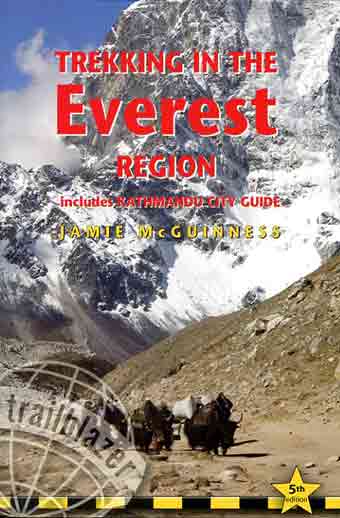


by Jamie McGuinness. The BEST trekking book I have ever used!! Highly Recommended. I have trekked extensively in Nepal, including the Everest region three times, and this is the BEST trekking book I have ever used. Ever!
The maps are especially detailed and accurate - perfect! The trekking times are consistent and accurate, allowing me to plan how far I want to trek in a given day. I like the fact that the guidebook only focuses on one region, giving it a lot more detail. I even use the Kathmandu City Guide for my stay in Kathmandu.

by Stan Armington. A classic trekking book detailing with good maps and route descriptions all of the favourite Nepalese treks, including Gokyo and Everest, Annapurna, Kangchenjunga, Manaslu, and Mustang.

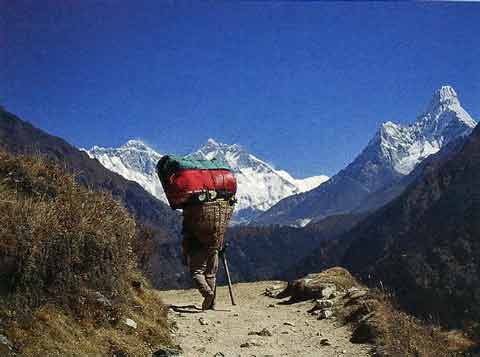

by Kev Reynolds. Kev has written some of my favourite trekking books. I've even learned that the timings he gives for each trek segment is exactly the time it takes me. There are almost 100 very good photos. He also includes a brief overview of the Tingri to Everest North base camp in Tibet. The book features very good descriptions of the treks, great photos, but the maps are basic.
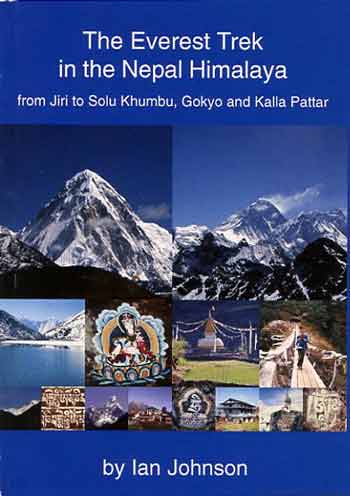
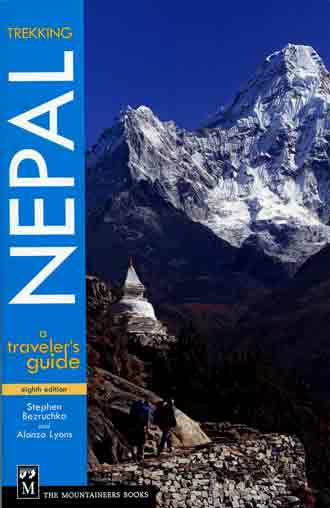

by Ian Johnson. This very small lightweight book by yetizone.com contains detailed day by day itineraries for the treks from Jiri or Lukla to Gokyo and Kala Pattar. Although there are no photos, there are very good drawings of some of the mountain views.

by Stephen Bezruchka and Alonzo Lyons. This book contains detailed route descriptions of the Annapurna Sanctuary and Circuit, Gokyo and Everest, Makalu, Langtang, Gosainkund, Helambu, and some rare treks like Rara Lake. There are only a few maps that are basic overviews and not detailed. There are 16 pages of colour photos and many b/w photos.

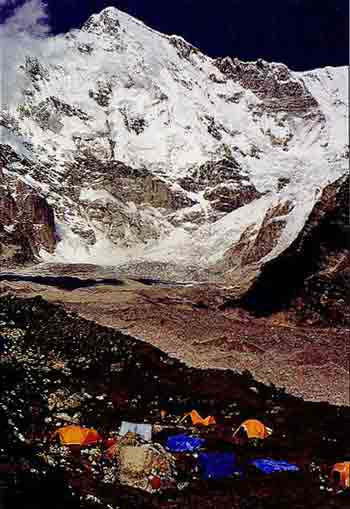

by Steve Razzetti. This book contains basic information on 25 treks in Nepal, including Humla to Mount Kailash, the Annapurna Sanctuary and Circuit, the Dhaulagiri Circuit, Jomsom to Mustang, Around Manaslu, Rolwaling, Gokyo and Everest, Makalu, and Kangchenjunga. It also contains descriptions of climbing 12 trekking peaks, including Pisang, Chulu, Ramdung, Lobuche East, Imja Tse, and Mera. The front cover is Annapurna South.
The book includes three pages on Gokyo and Cho La.Tumlingtar to Makalu, and two pages on the Three Cols from Chukung to Makalu.
The trekking route descriptions and maps are basic. The photos are very good.
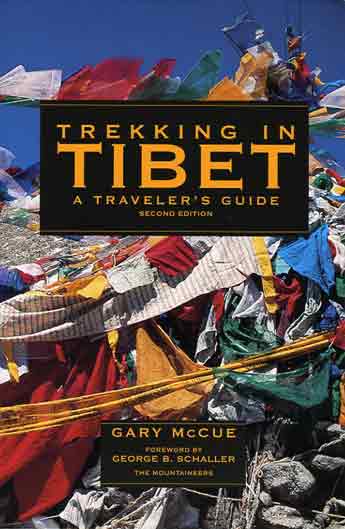
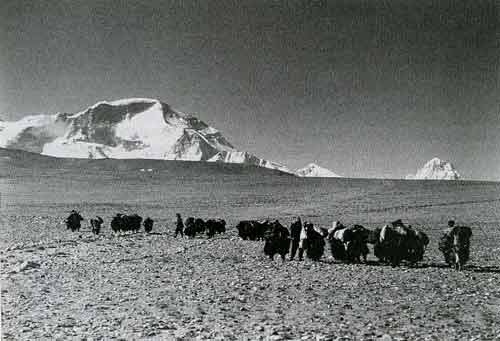
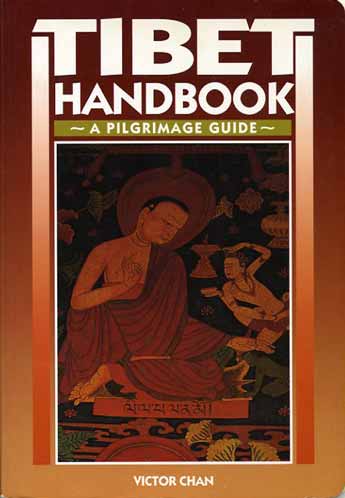

by Gary McCue. Highly recommended! An excellent book detailing the popular treks like Everest North Base Camp and Kailash Kora, and less common treks like Everest North Advanced Base Camp, Everest East Kangshung Base Camp, Shishapangma South and North Base Camps, Cho Oyu Advanced Base Camp, and Menlungtse.

by Victor Chan. Over a thousand pages, extremely detailed travel and pilgrimage guide. It has a page on the trek from Tingri to Cho Oyu Base Camp.

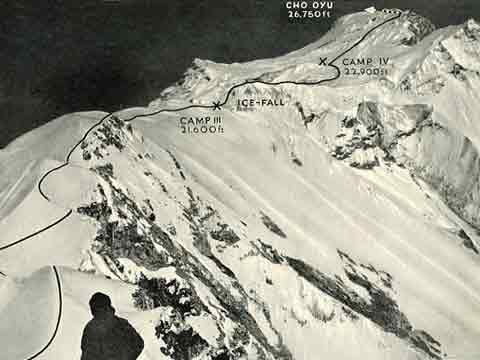
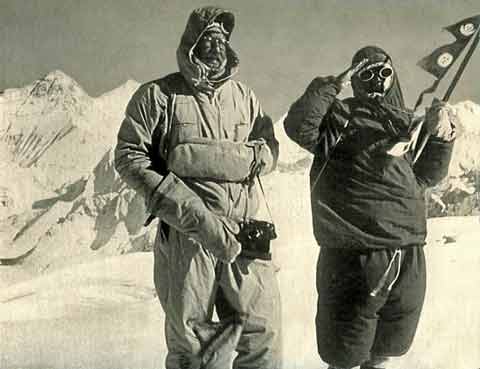

by Herbert Tichy. Published in English 1957. The book describes the first ascent of Cho Oyu by Austrians Herbert Tichy and Sepp Jochler, and Pasang Dawa Lama on October 19, 1954. In contrast to the huge expedition style sieges of the time, there was extremely small with only three climbers and seven Sherpas. There are 4 pages of colour photos and 32 pages of bw photos.
After trekking from Kathmandu via Namche Bazaar and the Nangpa La, their first attempt failed in fierce hurricane force winds. They regrouped, with Pasang having to descend to Namche to get more supplies. In just three days he went from Namche to the summit, a remarkable achievement. "Pasang embraced me. The tears that ran down his cheeks were blown away into eternity as crystals of ice. ... Sepp and I had tears in our eyes too, and felt no shame,. We hugged and kissed each other. How glad I was all three of us were there. All three walked arm in arm to the highest point." He closes the book with the celebrations in Namche and Pasang's wedding in Lukla.
I liked Tichy's spirit of adventure, his compassion for the Sherpas and their families, and almost spiritual prose. "I felt myself ... as glorious as God and at the same time no more than an insignificant grain of sand."
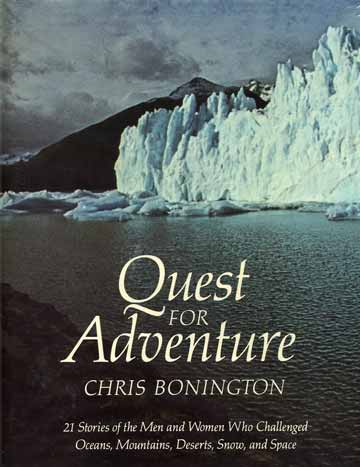
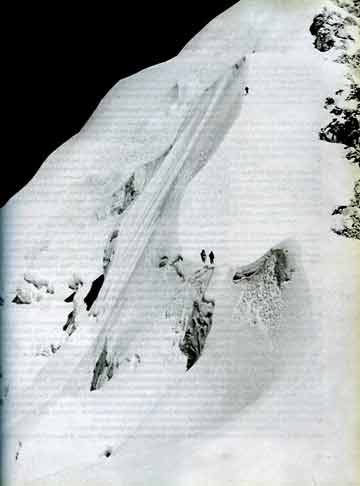
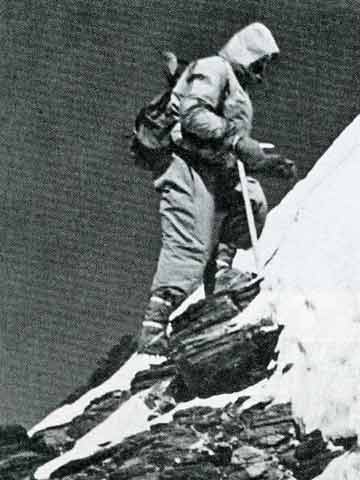

by Chris Bonington. Published 1981. The famed British mountaineer briefly describes 21 stories of adventure in 7 groups: 6 stories on Oceans, 1 on Deserts, 1 on Rivers, 7 on Mountains, 3 on The Poles, 1 on Air, 1 on Space, and 1 on Beneath The Earth. The mountains stories are the first ascents of Annapurna in 1950, Everest in 1953, Cho Oyu in 1954, and Broad Peak in 1957; Bonington's Annapurna South Face expedition in 1970, Reinhold Messner's solo ascent of Nanga Parbat in 1978, and Walter Bonatti's ascent of the Dru in 1955. There are 27 pages of colour photos, 31 pages of bw photos, 29 colour photos in line with text, 118 bw photos in line with text, 25 maps, and 10 mountain climbing routes.
The Cho Oyu chapter is 17 pages, with 2 pages of colour photos, 1 page bw photo, 7 bw photos in line with text, 1 map, and 1 climbing route. Bonington describes Herbert Tichy as a "romantic explorer ... happy wandering through the mountains, mingling with the mountain people, [but committed] to the chalenge of climbing Cho Oyu." Bonington briefly describes the trek to Base Camp, and setting up their high camps. A wind storm hit them at Camp 4, and Tichy plunged his bare hands into the snow to keep the tent from taking off, his hands soon becoming white and swollen with frostbite. They descended to Base Camp and Pasang was dispatched to Namche Bazaar to get more supplies.
With the arrival of Raymond Lambert who also wanted to climb Cho Oyu, Tichy, Sepp Jochler, and three Sherpas started for a second summit attempt. But they were pinned down at Camp 3 by another storm. "Tichy's hands were still badly swollen and he was unable to put on his own boots or even fasten the buttons on his clothing without help." Meanwhile Pasang raced back from Namche Bazar and caught up to Tichy as they started for Camp 4.
Austrians Herbert Tichy and Sepp Jochler, and Pasang Dawa Lama completed the first ascent of Cho Oyu on October 19, 1954. "The endless blue sky fell steeply all round us like a bell. To have reached the peak was glorious, but the nearness of the sky was overwhelming.'"
Bonington writes a compelling and interesting account of the first ascent of Cho Oyu. The photos, most from Tichy's book, are good.

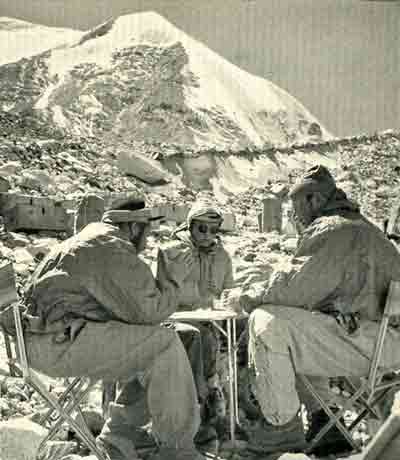
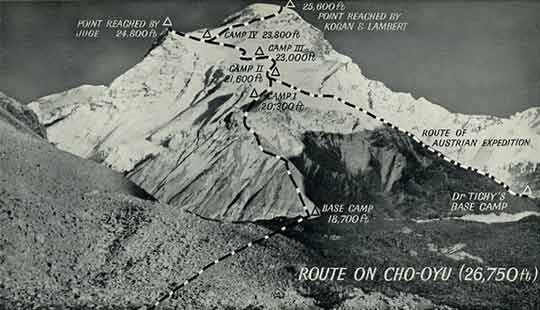

by Raymond Lambert and Claude Kogan. Published 1956. The book describes the 1954 five-person Swiss reconnaissance of Gauri Shankar and Menlungtse, and their attempt on Cho Oyu. There are 15 pages of bw photos. Lambert and Kogan wrote different chapters, sometimes covering the same days from their two different perspectives.
After trekking down the Rowaling Khola in Nepal, they entered Tibet via the Hadengi La and viewed the south and east faces of Gauri Shankar. They then trekked along the south face of Menlungtse, crossed the Menlung La back into Nepal and hiked up the Nangpa La to Cho Oyu. Herbert Tichy's three-person Austrian team was already there and became the first to climb Cho Oyu. Lambert and Kogan made it to 7800m before being turned back by repeated days of excessive wind.
"Sometimes we crawled on all fours; and when the worst gusts struck us it was fall flat on the stomach or be blown away. ... The wind was more violent than ever. ... The storm had gained strength. Nothing could be done."
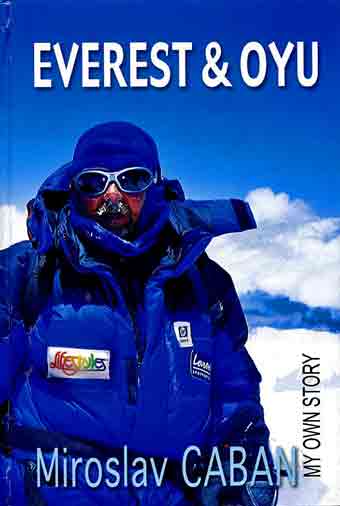
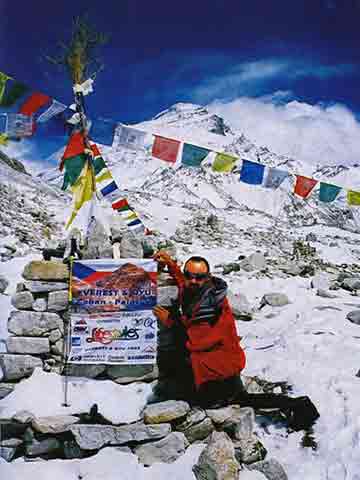


by Miroslav Caban. Published 2005. The book describes the author's Cho Oyu attempt and successful Everest North Face summit in 2002. He includes details of the changing weather forecasts and excerpts from his expedition log and copies of Emails from home. "There's the soul, the mind, and the body, working together in perfect harmony, striving for maximum teamwork, the goal of which is a short moment spent at the top spot of the planet." There are 56 pages of colour photos, 2 of them 4-page panoramas. There are 16 pages of colour photos dedicated to the Cho Oyu attempt.
The book starts with Miroslav Caban and his climbing partner Milos Palacky flying to Kathmandu and Lukla to attempt an acclimatizing trek to Moro La. After returning to Kathmandu, they drive to Tingri in Tibet and Cho Oyu Base Camp, and trek to Cho Oyu Advanced Base Camp (5700m). They acclimatize by climbing to Camp I (6400m) and Camp II (7200m) where "The weather turned incredibly fast. It was a hurricane in the Himalayas with winds of over 200 km/hour." After surviving three days pinned down by the storm they retreated to base camp, and after a rest started their last try at the summit. They struggled through deep snow, making it to 7800m before turning around because it was too late and their primary goal was to acclimatize for Everest. "This was our victory - a safe return."
After a brief rest in Tingri, they drive to Everest North Base Camp, and trek to Everest ABC (6400m). They climb to the North Col, where their porter deserts them. They ask their expedition agent to find another porter, and Milos waits for him at the North Col while Miroslav continues alone to Camp II (7500m), "determined to undergo the battle for the summit with all my powers, both physical and mental". Milos feels sick and decides not to continue, while Miroslav continues to Camp III (8300m). The new porter arrives, carrying only a bit of food, but no tent. Miroslav tries to persuade other mountaineers and Sherpas to let him sleep in their tents, but to no avail. He has to pay a Sherpa $100 to let him sleep in his tent.
Miroslav continues climbing alone without oxygen towards the summit. As he nears the summit, he sits down "I couldn't hold it back: exhaustion, sentiment, and joy brought water to my eyes. Now I'm gushing tears like a little kid, but I'm not ashamed. My life's goal is before my eyes." Miroslav Caban reached the Everest summit at 11:30 on May May 17, 2002. "The weather is beautiful. I step onto it with my right foot. My fantastic dream has become a reality. Here I am on the highest spot on the planet. ... The warm feeling of satisfaction I had from having organized the whole expedition myself heated my body."
The photos are absolutely excellent. This is a very entertaining, humorous and exciting read. His emails from home remind you that daily life continues at home, and accentuates the loneliness he often feels. Miroslav comes off a bit naive at first, getting sick drinking water, people ripping him off, hassles with jeep drivers and yak herders, and porters deserting him. Despite a very small budget that causes many issues, especially with porters, the author adapts to each new situation and preservers his seat-of-the-pants climb.
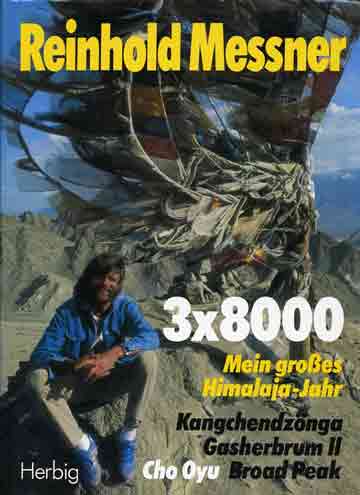
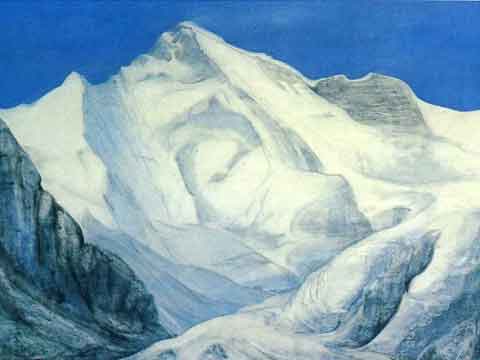


by Reinhold Messner. Published 1983. This coffee-table photographic book with text in German details Messner's ascents of Kangchenjunga on May 6, 1982, Gasherbrum II on July 24, 1982, Broad Peak on August 2, 1982, and Cho Oyu on May 5, 1983. Hmm, maybe it should have been called 4x8000? The chapter on Cho Oyu has 24 pages of colour paintings and photos from painter Luis Stecher; 23 pages of colour photos from the 1982 attempt and the 1983 ascent of Cho Oyu; 15 pages of text with 29 bw photos and 1 map; and an additional 3 colour and 2 bw photos.
For his December 1982 attempt to climb Cho Oyu by the southeast face, Messner invited painter Luis Stecher and author Bruno Laner to capture impressions of big mountains from the standpoint of men versus nature. Messner, Hans Kammerlander and Sherpa Ang Dorje reached the top of the south face on December 18, 1982, but decided to abandon the plateau to the summit because of the fear of avalanches in the hip and chest-deep powder snow.
Messner returned to Cho Oyu in the spring of 1983 with Hans Kammerlander and Michl Dacher. They trekked through Nepal towards the Nangpa La, setting up base camp on April 26, 1983. From ABC on the Nepalese side of the Nangpa La they climbed alpine style up the southwest ridge to the normal route on the southwest face, reaching the summit in just three days on May 5, 1983, the fourth ascent of Cho Oyu.
The paintings and photos of Cho Oyu are very good.

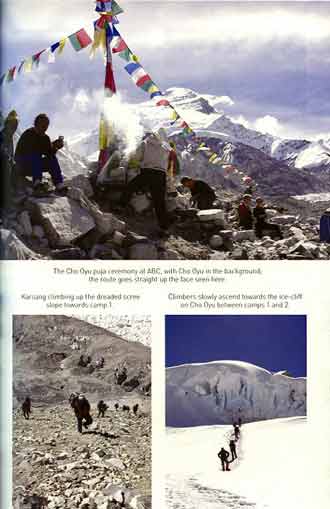
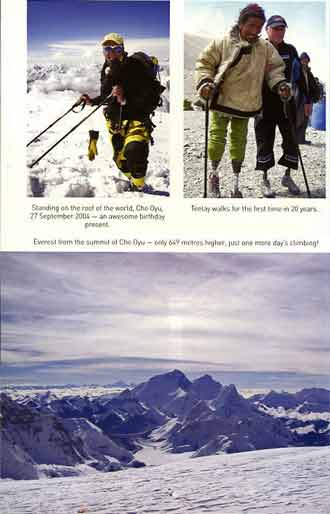


by Mark Inglis. Published 2006. After losing his legs below the knees to frostbite, Mark Inglis tells his day-by-day story of climbing Cho Oyu in 2004 and Mount Everest from the North in 2006, both with Russel Brice of HIMEX. He provides brief overviews of the structure of an expedition, Cheyne Strokes breathing, oxygen and altitude, the Everest north and south climbing routes, diarrhea, and mountain sickness. There are 16 pages of colour photos, 4 pages on Cho Oyu.
Inglis describes the daily life on an expedition including the mundane stuff like sleeping, eating, drinking beer, doing laundry, and using the toilet at high altitude. "Whisky with honey is the order of the day, though it's a beer for me after that as after one whisky I was just about legless - wrong, I was legless."
Inglis acclimitizes at Base Camp, Advanced Base Camp, and then climbs to Lake Camp and Camp 1. "Three steps before camp 1 I hear the dreaded 'ping', one of the two 'ankle joint' bolts shears and one of my feet goes seriously floppy. ... Ten minutes of work and the broken leg is fixed. Try doing that with bones, you guys. ... I'm now at 6350 metres. What an awesome place! I'm sorry if 'awesome', 'fantastic', 'amazing' seem to litter the text, but it really is that sort of place."
After spending nine days at Camp 1, Inglis starts for the summit on September 27, 2004, his 45th birthday. "After a few hours of climbing it flattens off to the summit plateau, a huge area the size of several football fields - so where the hell is the real top? Just follow the footprints, and sure enough, just after 8am we come to the streaming prayer flags that mark the summit. .. Look out Everest - I know damn well I can stand on your summit if you let me."
This book is a simply fun read. Mark Inglis writing is entertaining, funny, positive and direct. The photos are good.
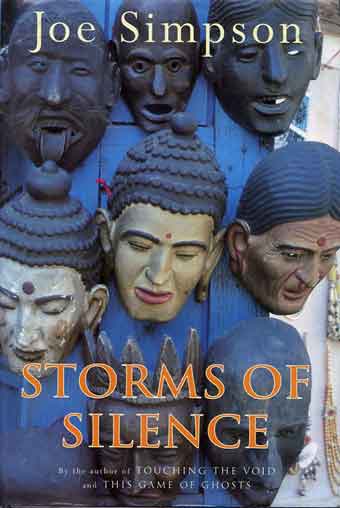
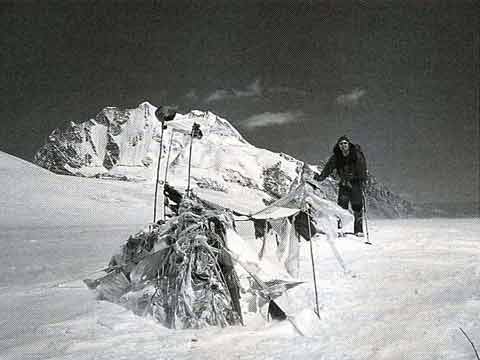
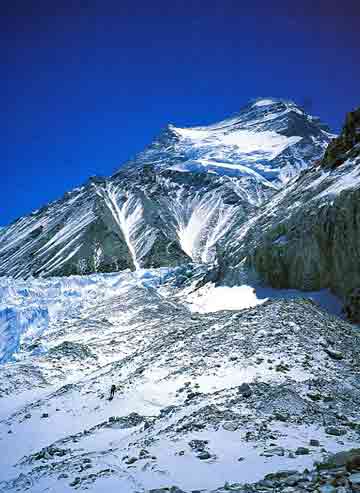

by Joe Simpson. Published 1996. The author of Touching The Void writes about expeditions to Gangchempo, Cho Oyu and Huascaran in Peru. There are 8 pages of colour photos, 13 pages of bw photos, and 29 bw photos in-line with text.
After a severe 5-day snow storm, Joe abandoned his attempt to climb Gangchempo (6400m) because of his injured knee. There are 4 pages of bw photos and 5 bw photos in-line with text.
Joe decided to abandon his attempt to climb Cho Oyu on a commercial expedition led by Mal Duff because of a throat infection and because he wasn't motivated after meeting Tibetan refugees fleeing over the Nangpa La into Nepal. There are 7 pages of colour photos, 5 pages of bw photos, and 15 bw photos in-line with text.
Joe successfully climbed several mountains in Peru, including Huascaran (6768m). He visited Yungay where an earthquake buried the town in 1970, killing tens of thousands. There is a 1 page colour photo, 4 pages of bw photos, and 9 bw photos in-line with text.
The Cho Oyu story is over half of the book, but actually has no climbing in it. It really is a description of the trek to the Nangpa La (5716m) from Nepal and Joe’s reaction to seeing Tibetan refugees. Joe starts in Kathmandu where he visits Pashupatinath and watches the preparation and creation at the burning ghats. He describes the flight to Lukla in bad weather in a lot of detail. He treks to Namche Bazaar, Thami, and to Ari, where he meets a group of teenage Khampa Tibetan refugees who have just crossed the Nangpa La. He reviews the Chinese invasion of Tibet and the impacts on the Tibetan people. He continues the trek to Base Camp about 6km before the Nangpa La, meeting another group of Tibetan refugees. He continues to the Nangpa La with views of Cho Oyu and many other mountains. "The sheer scale of these, the world’s highest mountains, was breathtaking and humbling. They induced in me a delight and a passion I could scarcely believe I possessed, and at the same time they would intimidate and humiliate me and quash any vain hopes I had of climbing them."
"Until then Tibet’s tragedy had been no more than words on a page to me; now seeing it stumble blindly past me, it was hard to comprehend. ... Climbing Cho Oyu appeared suddenly to be an absurdly pointless and selfish thing to do. ... For us, crossing the Nangpa La was one small event in a great adventure. To them, it was a once in a lifetime’s commitment – a poorly equipped arduous struggle into exile, fraught with the potential of death, or worse, capture, imprisonment and torture." Joe decides to pack it on and walked out by himself. He tries white water rafting and meets an old Gurkha soldier.
Joe tells a good story with a good slow pace, sharing his feelings and insights, and useing lots of conversation and humour to bring an immediacy to the story. The photos are very good.
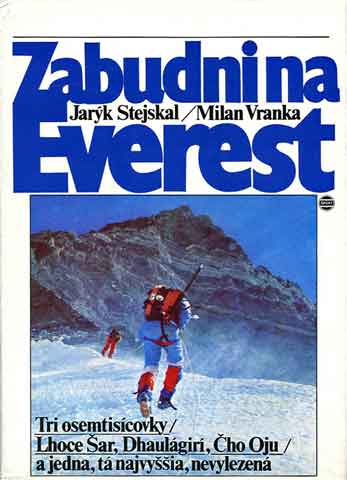

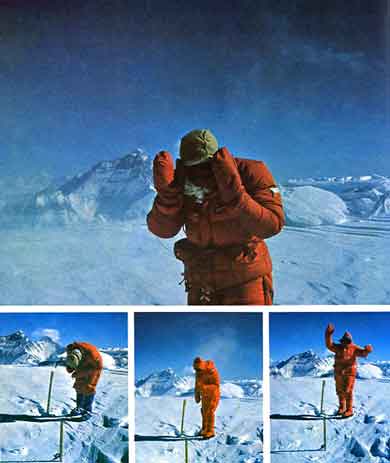

by Jaryk Stejskal and Milan Vranka. Published 1989 in Slovak. This book describes the first ascent of Lhotse Shar in May 1984, the first ascent of Dhaulagiri West Face in October 1984, an alpine winter ascent of Cho Oyu in December 1985, and an attempt on Everest in Spring 1987. There are 32 pages of colour photos, 14 pages of bw photos, 56 bw photos in-line with text, and 2 maps.
In the fall of 1985, Americans Pete Athens and Craig Ballenger, Brit Alan Burgess, Canadian Roger Marshall, and Solvaks Dusan Becik and Jaryk Stejskal attempted Cho Oyu in winter in alpine style. Jaryk Stejskal and Dusan Becik completed the second winter ascent of Cho Oyu on December 5, 1985, the first alpine style winter ascent of an 8000er. There are 8 pages of colour photos, 2 pages of bw photos, 12 bw photos in-line with text, and 1 map.
Even if you can't read Solvak, the photos are very good.
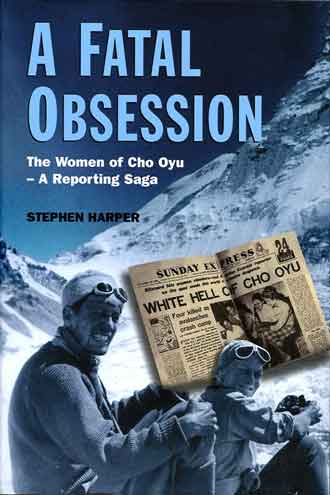
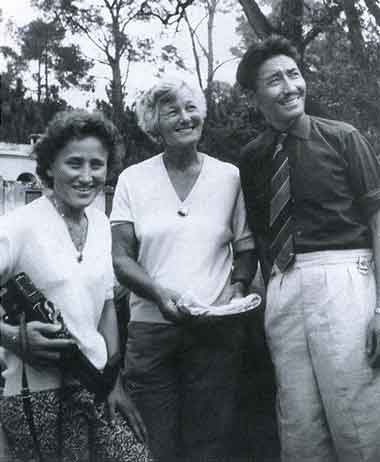
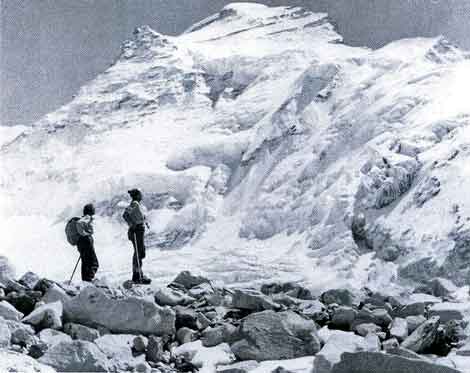

by Stephen Harper. Published 2007. Originally published as Lady Killer Peak in 1965. Turned around by Swiss mountaineer Raymond Lambert at Cho Oyu high camp in 1954, Madame Claude Kogan arranged an all-women’s expedition to attempt Cho Oyu in the fall of 1959. Tragedy struck when Kogan, Claudine van der Stratten, and Sherpa Ang Norbu were trapped at their high camp, and killed by an avalanche. Two Sherpas were hit by an avalanche trying to rescue them, with Sherpa Chewang being killed. "Finally, I struggled free , and tried to take in the rope to find Chewang. He was buried too deep."
The author was a newspaper journalist covering the attempt. He describes his trek from Kathmandu to Namche, across the Nangpa La to Cho Oyu base camp in Tibet. He brings together diaries and interviews to retell the expedition attempt and tragedy. There are 12 pages of bw photos.
The story is fairly basic. The photos are good, especially the two photos of Tenzing Norgay who arranged the Sherpa support for the team.
Cho Oyu is also featured in many general mountaineering books. Here are my favourites:

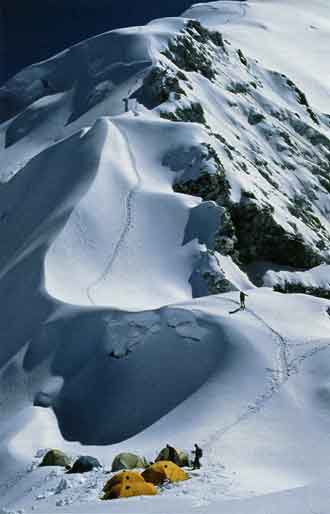
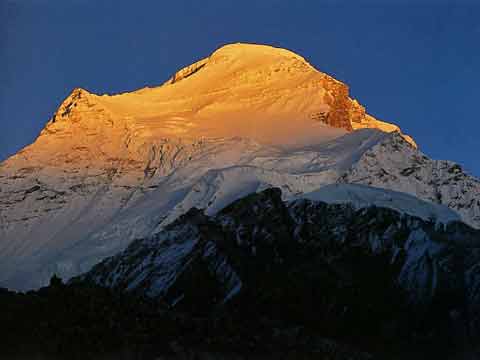

by Richard Sale, John Cleare ((Photographer). Published 2000. Highly recommended! The book details the exploration, first ascent, and other major ascents of all 14 8000m peaks, including spectacular photos.

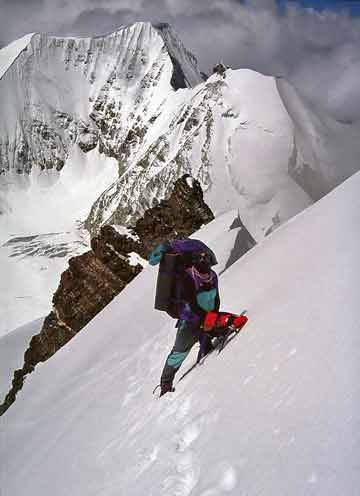
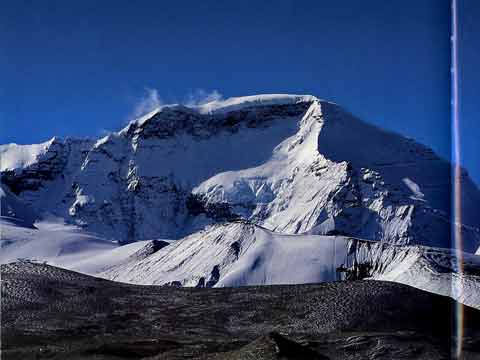

by Marco Bianchi. Published 2003. Although the title claims to be the 14 highest summits in the world, this beautiful, large-format photo book really focuses on the seven mountains the author climbed. The text is in Spanish, but the photos transcend language.
After attempts on Makalu in 1986 and Cho Oyu in 1989, Bianchi summitted seven of the 14 8000m peaks: Manaslu Sept. 28 1992 via Northeast Face, Broad Peak July 6 1993 via Normal route, Cho Oyu September 18 1993 via Southwest Ridge, Shishapangma October 6 1993 via Southwest Face, Dhaulagiri September 25 1994 via Northeast Ridge, Everest May 12 1995 via Northeast Ridge, and K2 August 10 1996 via North Ridge.
There are some pages of the Tibet approach from Kathmandu, and 10 pages on Cho Oyu from his climb of the Southwest Ridge with Krzysztof Wielicki. The photos are excellent.
You can preview many of the photos at cuboimages.it by searching for Cho Oyu.
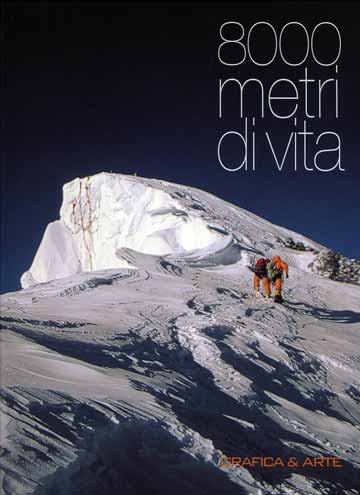
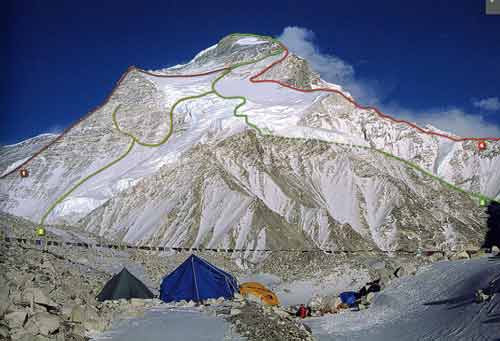
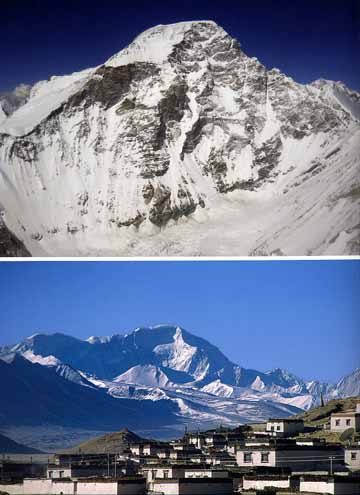

by Simone Moro. Published 2008. In Italian and English. This coffee-table size book features excellent photos from all 14 8000m peaks. Each 8000m peak has a brief history, a photo of each face showing the climbing routes, and lots of excellent photos.
There are 8 pages on Cho Oyu. Simone Moro reached the summit of Cho Oyu (8201m) in only 11 hours of climbing, on May 9, 2002.
The photos and route diagrams are excellent.

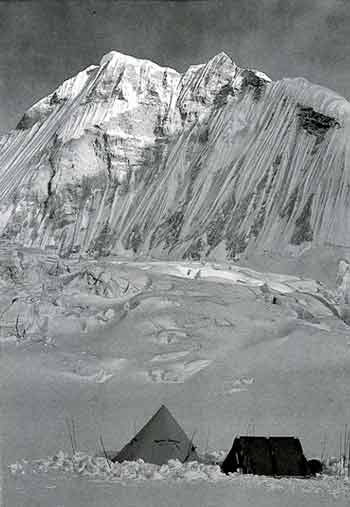
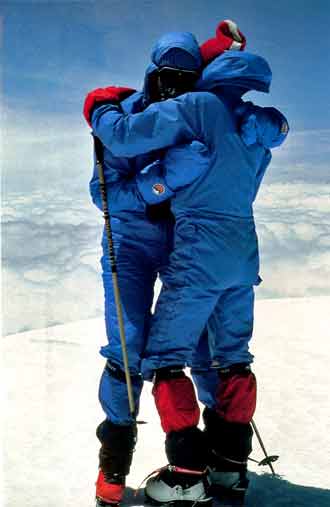

by Reinhold Messner. Published 1999. One of Michael Chessler's Top 100 Mountaineering Books. Messner briefly details his ascents of all 14 8000m peaks, documented with his photos. He also includes route diagrams and some basic history of the first few ascents. Messner was the first climber to summit all 14 mountains over 8000 metres in height, beginning with Nanga Parbat on June 27, 1970 and finishing with Lhotse on October 16, 1986.
On May 5, 1983 Messner, Hans Kammerlander, and Michl Dacher complete a partly new route on the south-west side, the fourth ascent of Cho Oyu.
The photos are very good.



by Andy Fanshawe, Stephen Venables. Published 1996. This book briefly details 40 of the world's finest climbs on mountains in Pakistan (including Broad Peak, K2 and Nanga Parbat), India, Nepal and Tibet (including Annapurna, Shishapangma, Cho Oyu, Everest, Makalu and Kangchenjunga). Each climb is illustrated with many excellent photos, climbing routes, and summary statistics and information. Each area has an excellent overview map.
There are 4 pages on Cho Oyu North-West Ridge.
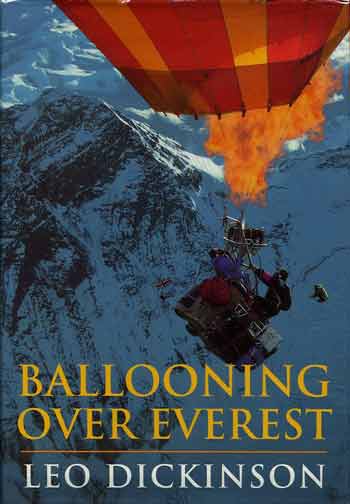
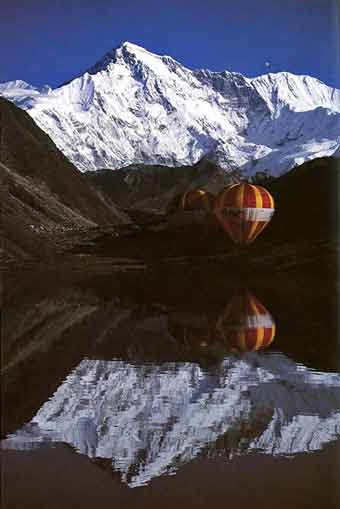
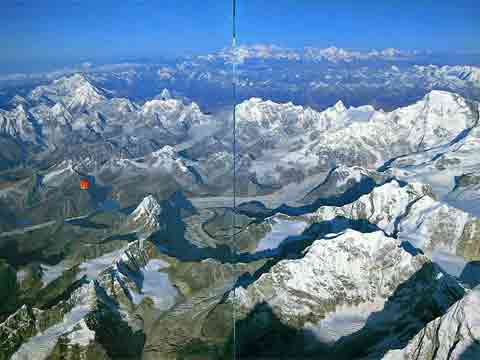

by Leo Dickinson. Published 1993. This book tells the story of the author's quest to be the first person to fly a balloon over Mount Everest. The book starts with getting the expedition financed and then trekking to Gokyo. They wait over three weeks for the right winds, and then the two balloons took off from Gokyo on October 21, 1991.
?"Peter became quite emotional and shed a tear or two. ... May you fly so high and so well, that God will join you in your laughter and set you gently back in the loving arms of mother earth."
Leo Dickinson was in the first balloon, and everything went well until the end, when they crash landed in Tibet, spinning violently. The second balloon got in terrible early when their burners failed several times as they flew towards the Western Cwm. They managed to relight them each time and landed safely in Tibet.
The photos of Everest, Lhotse, Nuptse, Cho Oyu and Makalu are sensational, taken from an overhead angle I have not seen before. There are eight photos containing Cho Oyu, with more of the trek to Gokyo and Gokyo itself.
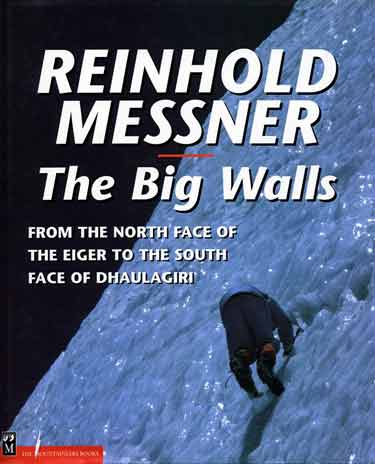
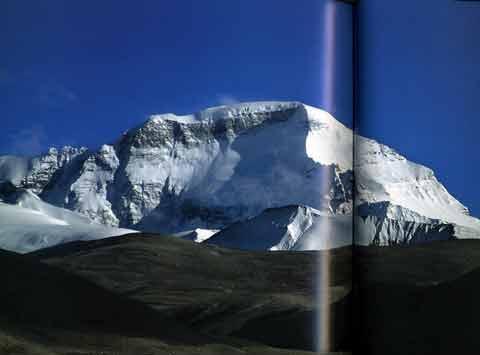
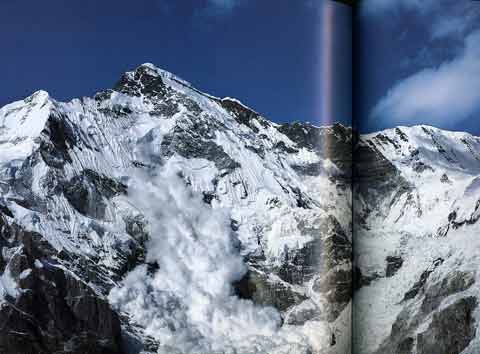

by Reinhold Messner. Revised in 2001. Messner briefly details the big mountain walls in the world in the Himalayas, the Karakorum, the Alps, South America, Alaska and the Caucasus.
It includes a photo, a 2-page photo, and two pages on climbing Cho Oyu South-East Face and South-West Face.
I like this as a reference book. The photos are very good.
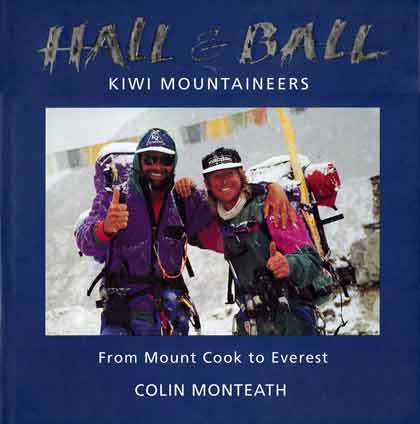
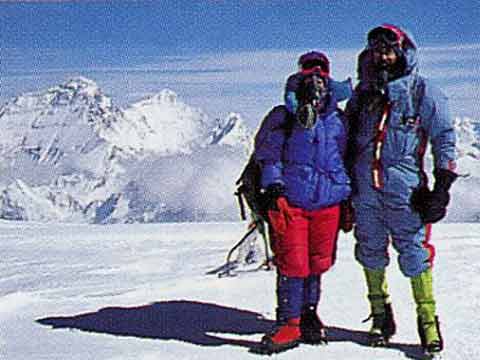
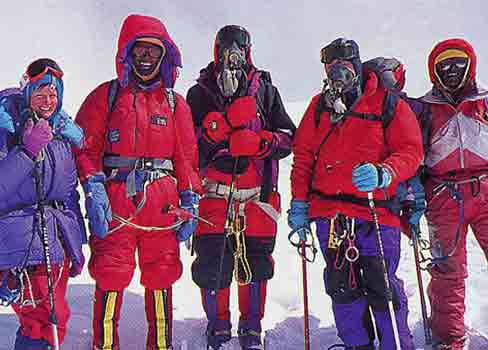

by Colin Monteath. Published 1997. This book details the climbing adventures of fellow-kiwis Gary Ball and Rob Hall. In addition to the big climbs on Everest, K2, Dhaulagiri, Lhotse, Cho Oyu, and Makalu, the book also profiles their climbs on Mount Cook, Antarctica, Pik Kommunizma, and Ama Dablam. After their first ascent on Everest they climbed the 7 summits in only 7 months. Hall and Ball will be remembered for pioneering commercial guided expeditions, with their Adventure Consultants company leading 39 climbers to the top of Everest from 1990 to 1995.
The section on Cho Oyu is 2 pages with 5 small colour photos. Rob Hall reached the summit of Cho Oyu on October 5, 1994 with Ed Viesturs and his wife Jan Arnold. Rob reached the Cho Oyu summit again on September 26, 1995 on the Adventure Consultants guided expedition, along with Jan and two clients.
The photos are excellent.


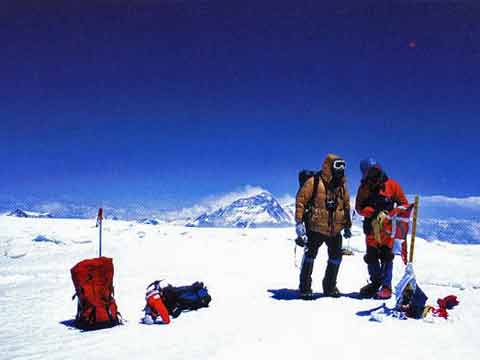

by Kiko Betelu. Text in Spanish. Spaniard Juanito Olarzabal became the sixth mountaineer to summit all 14 8000m peaks when he reached the summit of Annapurna on April 29, 1999. This book reviews each of his 14 ascents with text, photos, and a route map. There are 65 colour photos and 42 bw photos. With his ascent of Annapurna on April 27, 2010, Juanito holds the record for the most ascents of 8000m peaks with 24.
A 13-page chapter with 6 colour photos and 4 bw photos describes Oiarzabal's first ascent of an 8000er, Cho Oyu via the Northwest Face on May 1, 1985.
The photos are very good.
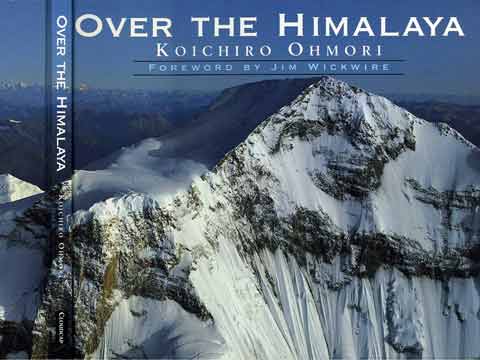


by Koichiro Ohmori. Published 1998. One of Michael Chessler's Best Mountain Photo Books. This book features 44 spectacular 2-page aerial photos of the 8000m Nepalese mountains - Kangchenjunga, Makalu, Everest and Lhotse, Cho Oyu, Manaslu, Annapurna and Dhaulagiri (cover) - and several others, including Jannu, Nuptse, and Ama Dablam. Route diagrams and some basic history of the first few ascents are also included.
There is one 2-page photo of Cho Oyu and Gyachung Kang, and one of the Ngojumba Glacier.

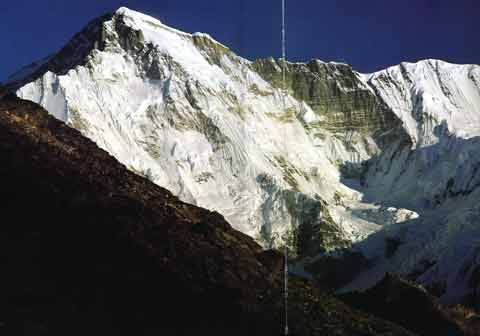

by Shiro Shirahata. Published 1983. One of Michael Chessler's Best Mountain Photo Books. A large, heavy quality paper, coffee-table type book featuring 115 spectacular photos, over half double-pages, of the 8000m Nepalese mountains - Kangchenjunga, Makalu, Everest and Lhotse (cover), Cho Oyu, Manaslu, Annapurna, Dhaulagiri - and many others, including Jannu, Nuptse, and Ama Dablam.
There are xx pages with 13 photos of the Dhaulagiri region - three double-page photos and two single-page photos of Dhaulagiri's different faces. Other photos include Tukuche Peak and Dhaulagiri II, III, V and VI.


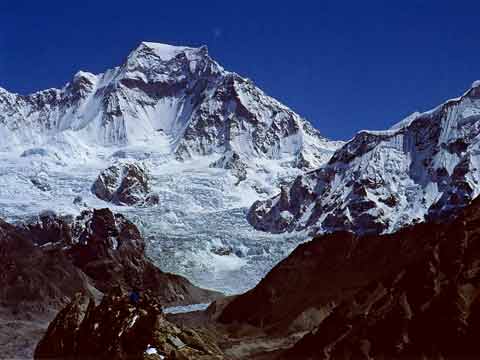

by Laurent Doldi. Published 2006. In French and English. A large soft-cover photo book detailing 10 Himalayan treks: K2 Base Camp (12 pages. 23 photos), Ladakh to Zanskar (16 pages, 38 photos), Jeep tour in Kinnaur Spiti and Ladakh (12 pages, 32 photos), the Sources of the Ganges in India (14 pages, 30 photos), Dolpo (18 pages, 36 photos), Around Annapurna (22 pages, 45 photos), Helambu and the sacred lakes of Gosainkund (16 pages, 29 photos), Rolwaling Valley in winter (18 pages, 37 photos), Everest Base Camp and Gokyo Lakes (20 pages, 41 photos), and Kangchenjunga Base Camps in Nepal (21 pages, 44 photos). Each chapter starts with a very brief overview including a map and altitude profile. The front cover is K2. There are 360 colour photos.
This is very good companion book to a trekking guide, enabling you to visualize what you will experience on a trek. The photos are very good.
Cho Oyu expedition news:
Cho Oyu information:
Cho Oyu expedition photo galleries:
Cho Oyu photo galleries and travelogues:
In addition to youtube.com videos, I found the following DVD:
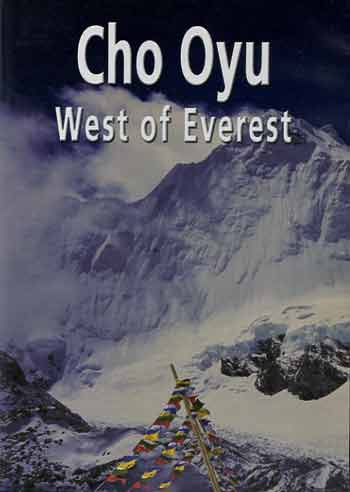
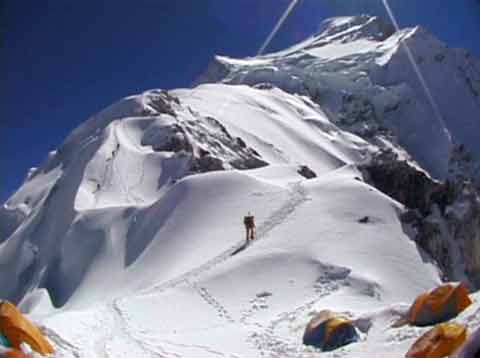
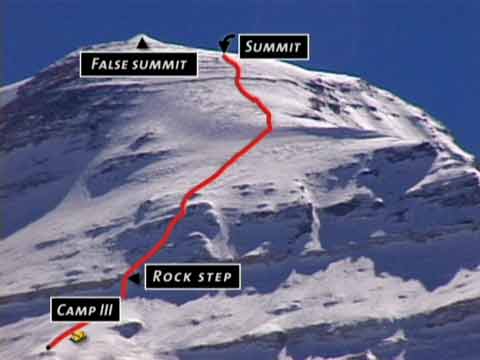

Produced, directed and written by Tim Boelter. Documents the 2000 expedition of 21 climbers attempting Cho Oyu from the Tibet side. Also check out mountainzone.com.
The story line is fairly straightforward following the team driving from Kathmandu to Tibet Base Camp, trekking to ABC, and then the climbing to the camps on the mountain. I liked the filming, giving me a better appreciation for Cho Oyu, especially the challenge of the rock step on summit day. It nicely highlights the ordinary challenges of attempting high altitude climbing, things like trouble acclimatizing, stomach troubles, coughing, and snow blindness.
On October 3, 2000 Tim Boelter, Expedition Leader Dan Mazur, and Durge Tamang reached the true 8201m summit of Cho Oyu. On October 10th the team helped an exhausted Serbian climber, who was suffering from pulmonary edema, down from Camp I. The rescue turned out sadly when he died when his heart went into fibrillation.